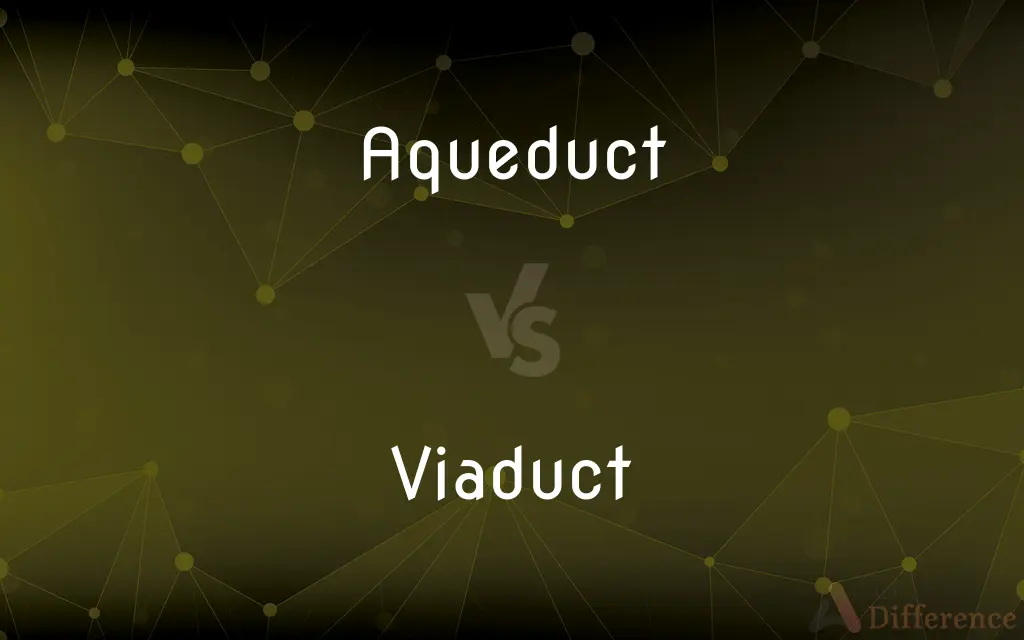Aqueduct vs. Viaduct — What's the Difference?
Edited by Tayyaba Rehman — By Maham Liaqat — Updated on April 1, 2024
An aqueduct is designed to transport water from one location to another, often across valleys or obstacles, while a viaduct is a bridge that carries a road or railway over a valley, water, or another road.

Difference Between Aqueduct and Viaduct
Table of Contents
ADVERTISEMENT
Key Differences
Aqueducts are primarily constructed to move water from a remote source to urban centers for drinking, irrigation, and sanitation purposes. They can be underground tunnels or above-ground bridges. Whereas, viaducts are built to support roads and railways, enabling them to cross over obstacles like rivers, valleys, or other roads, without interrupting the path below.
While aqueducts have been pivotal in the development of ancient civilizations by providing a steady water supply, viaducts have played a crucial role in modern infrastructure by facilitating transportation. Viaducts, with their complex engineering, allow for the uninterrupted flow of traffic over geographical barriers.
The design of aqueducts is primarily focused on maintaining a gradual slope to ensure the natural flow of water, often incorporating siphons, tunnels, and canals. On the other hand, viaducts are engineered to support heavy loads, with considerations for height, length, and structural integrity paramount in their design.
Historically, aqueducts were constructed using stone, brick, and concrete, showcasing the architectural prowess of ancient civilizations like the Romans. Viaducts, however, are built with modern materials such as steel and reinforced concrete, reflecting advancements in engineering and materials science.
Aqueducts, while functional, are also celebrated for their aesthetic beauty and historical significance, often becoming tourist attractions. Viaducts, while primarily functional, have also evolved into architectural marvels, with some becoming iconic landmarks due to their design and scale.
ADVERTISEMENT
Comparison Chart
Primary Function
Transports water
Carries roads or railways
Construction Era
Ancient to modern
Primarily modern
Design Focus
Maintaining a gradual slope for water flow
Structural integrity for heavy loads
Material Used
Stone, brick, concrete
Steel, reinforced concrete
Significance
Historical, architectural beauty
Modern infrastructure, occasionally iconic
Compare with Definitions
Aqueduct
A bridge-like structure supporting a conduit or canal passing over a river or valley.
The aqueduct near the city spans a wide valley, providing water to the townsfolk.
Viaduct
An elevated roadway or railway supported by a series of arches or spans.
The elevated viaduct provides a direct route over the urban landscape.
Aqueduct
A structure designed to transport water from a remote source to urban areas.
Ancient civilizations built aqueducts to bring water to their cities from distant rivers.
Viaduct
A structure composed of multiple small bridges connected together to span a large distance.
The viaduct crosses the entire length of the valley, enabling uninterrupted travel.
Aqueduct
A canal or ditch used for irrigation purposes.
Farmers in the region rely on a small aqueduct to water their crops during dry seasons.
Viaduct
A construction achievement that facilitates efficient transportation over difficult terrain.
The construction of the viaduct was a major engineering feat that improved connectivity.
Aqueduct
A conduit for water, especially one for carrying a large quantity of flowing water.
The Roman aqueducts are among the greatest achievements of ancient engineering.
Viaduct
A long bridge-like structure that carries a road or railway across a valley or other low ground.
The Millau Viaduct in France is one of the tallest and most spectacular in the world.
Aqueduct
A significant architectural work that delivers water across a considerable distance.
The Segovia Aqueduct is not only functional but also a stunning tourist attraction.
Viaduct
A bridge that carries traffic over water, another road, or any obstacle.
The coastal road includes a viaduct that overlooks the sea, offering stunning views.
Aqueduct
A pipe or channel designed to transport water from a remote source, usually by gravity.
Viaduct
A viaduct is a specific type of bridge that consists of a series of arches, piers or columns supporting a long elevated railway or road. Typically a viaduct connects two points of roughly equal elevation, allowing direct overpass across a wide valley, road, river, or other low-lying terrain features and obstacles.
Aqueduct
A bridgelike structure supporting a conduit or canal passing over a river or low ground.
Viaduct
A long bridge-like structure, typically a series of arches, carrying a road or railway across a valley or other low ground.
Aqueduct
(Anatomy)A channel or passage in an organ or a body part, especially such a channel for conveying fluid.
Viaduct
A series of spans or arches used to carry a road or railroad over a wide valley or over other roads or railroads.
Aqueduct
An artificial channel that is constructed to convey water from one location to another.
Viaduct
(transport) A bridge with several spans that carries road or rail traffic over a valley or other obstacles.
Aqueduct
A structure carrying water over a river or depression, especially in regards to ancient aqueducts.
Viaduct
A structure of considerable magnitude, usually with arches or supported on trestles, for carrying a road, as a railroad, high above the ground or water; a bridge; especially, one for crossing a valley or a gorge. Cf. Trestlework.
Aqueduct
(anatomy) A structure conveying fluid, such as the cerebral aqueduct or vestibular aqueduct.
Viaduct
Bridge consisting of a series of arches supported by piers used to carry a road (or railroad) over a valley
Aqueduct
A conductor, conduit, or artificial channel for conveying water, especially one for supplying large cities with water.
Aqueduct
A canal or passage; as, the aqueduct of Sylvius, a channel connecting the third and fourth ventricles of the brain.
Aqueduct
A conduit that resembles a bridge but carries water over a valley
Common Curiosities
Are there any famous examples of aqueducts?
The Pont du Gard in France and the Aqueduct of Segovia in Spain are famous examples.
Can aqueducts still be used today?
Yes, modern aqueducts are used for water supply and irrigation.
How does a viaduct differ from a regular bridge?
A viaduct spans longer distances over valleys or other obstacles, often consisting of multiple spans or arches.
What is the significance of viaducts in modern infrastructure?
They facilitate transportation and connectivity across challenging landscapes.
Are aqueducts only used for water supply?
Primarily, but they can also be used for irrigation and decorative purposes.
What makes viaducts different from elevated highways?
Viaducts specifically span over natural or man-made obstacles, while elevated highways can be built over any terrain.
How did ancient civilizations build aqueducts?
They used stone, brick, and concrete, relying on gravity for water flow.
What is the main purpose of an aqueduct?
To transport water from a remote source to urban centers for various uses.
What materials are commonly used in building viaducts today?
Steel and reinforced concrete are prevalent in modern viaduct construction.
How do aqueducts and viaducts impact the environment?
Both can alter landscapes but are designed to minimize environmental disruption.
What role did aqueducts play in ancient Rome?
They were crucial for supplying water to cities, supporting public baths, fountains, and sanitation.
What are some challenges in constructing viaducts?
Engineering challenges include ensuring structural integrity over long spans and difficult terrains.
Can viaducts be considered architectural landmarks?
Yes, some viaducts are celebrated for their design and scale, becoming iconic landmarks.
How do modern viaducts address safety and longevity?
Through advanced materials and engineering techniques to ensure durability and resistance to natural forces.
Can aqueducts be navigated by boats?
Some aqueducts, designed as navigable aqueducts, can carry boats over obstacles.
Share Your Discovery

Previous Comparison
Laps vs. Lapse
Next Comparison
Sign vs. SignifierAuthor Spotlight
Written by
Maham LiaqatEdited by
Tayyaba RehmanTayyaba Rehman is a distinguished writer, currently serving as a primary contributor to askdifference.com. As a researcher in semantics and etymology, Tayyaba's passion for the complexity of languages and their distinctions has found a perfect home on the platform. Tayyaba delves into the intricacies of language, distinguishing between commonly confused words and phrases, thereby providing clarity for readers worldwide.














































